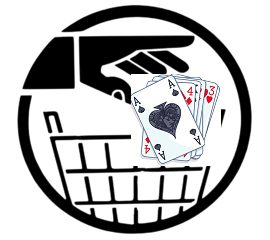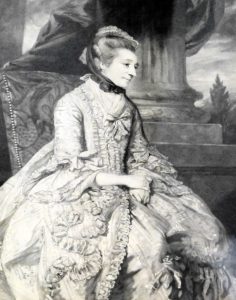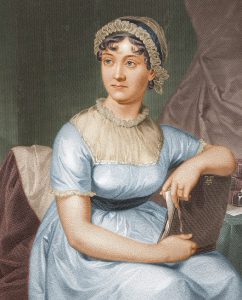If you’re Elizabeth Montagu in the 18th century, and you get some of your friends together, what do you do? Do you talk about fashion? Continue being centerpieces of a patriarchal society? Maybe play cards?
Hell no, you strap on your fancy stockings, and you talk ARTS and SCIENCES.
Not in this house.
The middle of the 18th century saw the formation of The Blue Stockings Society, an informal, discussion group dedicated to the perverse idea that women should engage intellectually with the world. Riding the trendy, Enlightenment wave of the French salon (Hinder), Elizabeth Montagu, Elizabeth Versey, Frances Boscawen, and others would meet to discuss art, politics, literature, and other stimulating topics, the knowledge of which was widely considered to be unbecoming of women at the time (Vickery).
Elizabeth Montagu, og feminist
The group’s ideology helped shape and generate feminist writing of the time (Pohl 2).
For example, member and poet Anna Laetitia Barbauld’s poem, “The Rights of Women:”
Yes, injured Woman! rise, assert thy right!
Woman! too long degraded, scorned, opprest;
O born to rule in partial Law’s despite,
Resume thy native empire o’er the breast!
Go forth arrayed in panoply divine;
That angel pureness which admits no stain;
Go, bid proud Man his boasted rule resign,
And kiss the golden sceptre of thy reign.
Subtle.
Their influence on literature extends beyond original content. Elizabeth Carter translated Epictetus (Vickery), giving the English the gift of stoicism, which is very much still part of the England’s psyche (Use “sorry” more, please) (Eger 109). More immediately, Carter’s work with stoicism directly influenced writers of the time like Jane Austen (Pohl 11).
So brooding, and yet, so stoic
The group also had numerous notable male members, including famous writers James Boswell and Samuel Johnson, “arguably the most distinguished man of letters in English history” and also arguably part of the greatest bromances in English literary history (Boswell wrote Johnson’s biography). In fact, the name “Bluestocking” comes from an anecdote relating to known botanist and translator at the time, Benjamin Stillingfleet — because why would a group of women get their name from something other than a man –, who was too poor to have the formal black silk stockings, so he attended every meeting in blue stockings (Knowles).
Johnson, all up in some books
A more inclusive list of attendees that shows just how variant this bright group was includes(Knowles, Haslett, Pohl):
-poet James Beattie
-author Mrs. Harriet Bowdler, who may not have been a regular attendee but rocked some blue stockings
-statesman, philosopher, and politcal theorist Edmund Burke, who, being Irish, supported the reasoning behind the American Revolution
-satirical novelist, diarist, and playwright Fanny Burney (Schellenbrg)
-Margaret Bentinck, Duchess of Portland, who had the largest natural history collection in Britain
-painter Sir Joshua Reynolds
-son of the British Prime Minister, art historian, and general man of letters Horace Walpole
-poet (and companion to Samuel Johnson) Anna Williams
The Blue Stockings Society’s works have seen a resurgence in recent years due in large part to a revival of old school, feminist literature by modern feminist scholars, many of whom’s ideas have been in some way influenced by the work of the Blue Stockings Society.
-Jonathan Griffey
Bibliography
Eger, Elizabeth. “Paper Trails And Eloquent Objects: Bluestocking Friendship And Material Culture.” Parergon: Journal Of The Australian And New Zealand Association For Medieval And Early Modern Studies 26.2 (2009): 109-138. MLA International Bibliography. Web. 1 Feb. 2017.
Encyclopedia Britannica, 2007. www.britannica.com/topic/Bluestocking-British-literary-society. 1 February 2017. Web.
Haslett, Moyra. “Becoming Bluestockings: Contextualising Hannah More’s ‘The Bas Bleu’.” Journal For Eighteenth-Century Studies 33.1 (2010): 89-114. Historical Abstracts with Full Text. Web. 1 Feb. 2017.
Hinder, Heidi. “Bluestockings With An Itch For Scribbling.” Medal 63 (2013): 52-55. Art & Architecture Source. Web. 1 Feb. 2017.
Knowles, Rachel. 2014. www.regencyhistory.net/2014/02/the-bluestocking-circle.html. 1 February 2017. Web.
Pohl, Nicole, and Betty A. Schellenberg. “Introduction: A Bluestocking Historiography.” Huntington Library Quarterly 2002: 1. JSTOR Journals. Web. 1 Feb. 2017.
Schellenberg, Betty A. “The Bluestockings And The Genealogy Of The Modern Novel.” University Of Toronto Quarterly 4 (2010): 1023. Project MUSE. Web. 1 Feb. 2017.
Vickery, Amanda. The Guardian, 2008. www.theguardian.com/books/2008/mar/08/art. 1 Feburary 2017. Web.




